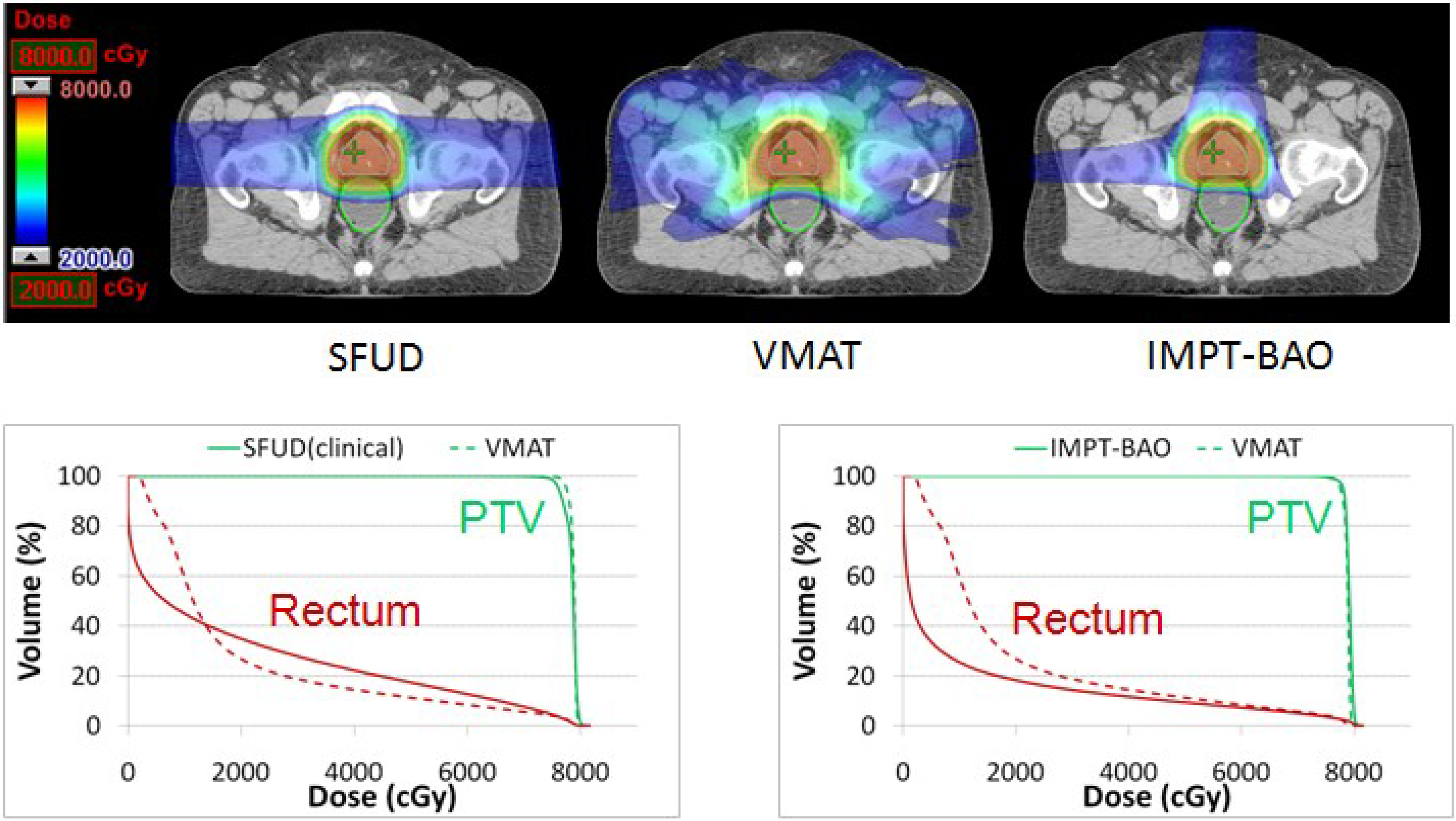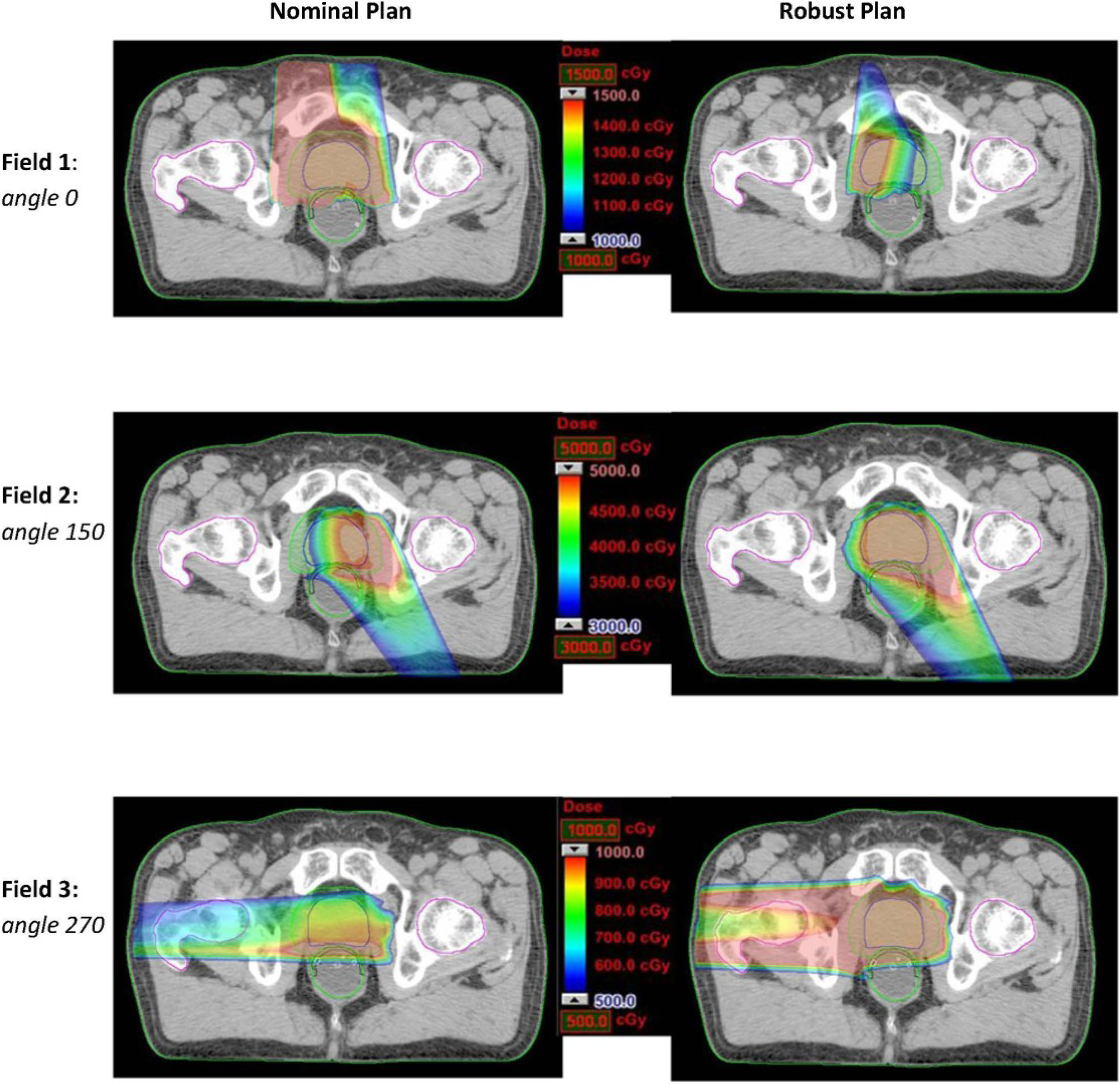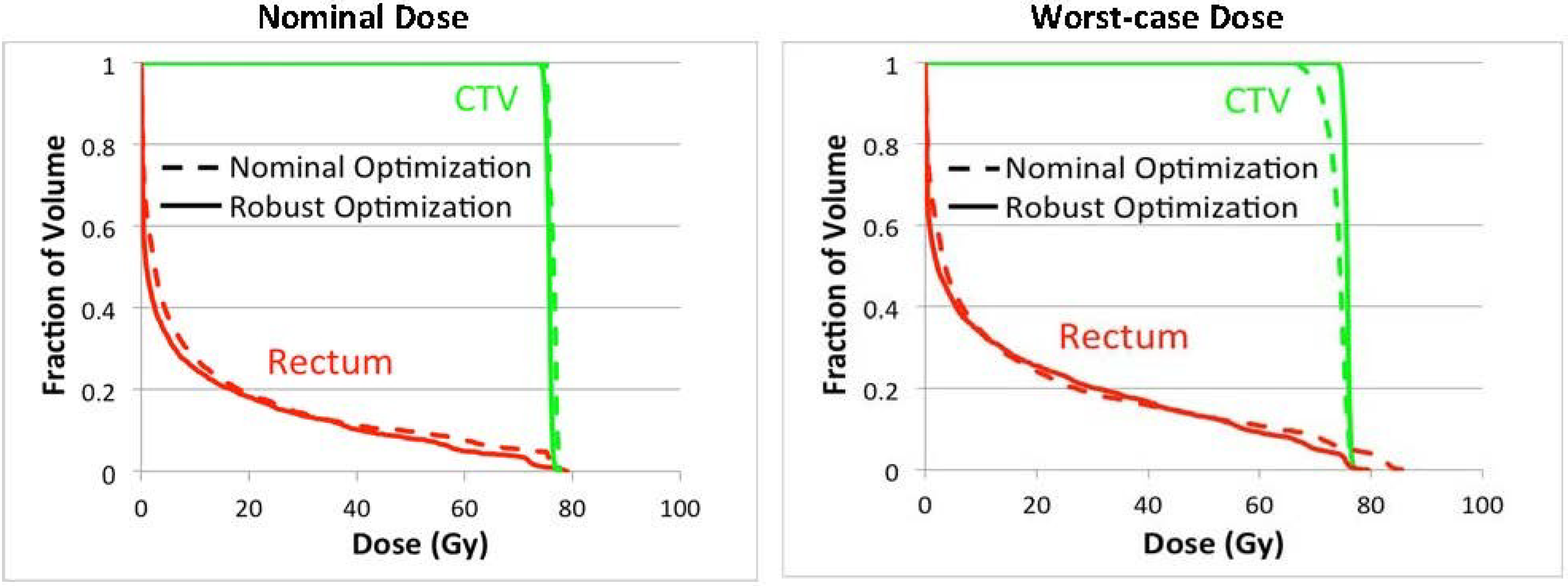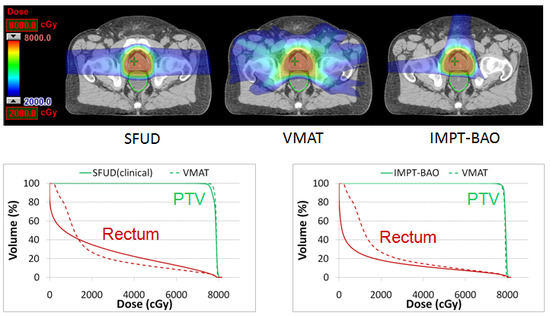Improved Beam Angle Arrangement in Intensity Modulated Proton Therapy Treatment Planning for Localized Prostate Cancer
Abstract
:1. Introduction
2. Materials and Methods
3. Results
| ROI | Statistic * | Two Angles (Conventional) | Two Angles (Optimized) | Three Angles (Optimized) | Four Angles (Optimized) | Three Angles ** (Class) | |
|---|---|---|---|---|---|---|---|
| Rectum | V30Gy (%) | 22.6 | 16.8 | 15.7 | 16.0 | 15.9 | (29.6%) |
| V40Gy (%) | 18.2 | 13.9 | 12.6 | 13.2 | 12.8 | (29.7%) | |
| V50Gy (%) | 14.4 | 11.3 | 10.2 | 10.7 | 10.7 | (25.7%) | |
| V60Gy (%) | 10.8 | 8.9 | 8.0 | 8.4 | 8.3 | (23.1%) | |
| V70Gy (%) | 6.9 | 6.2 | 5.7 | 5.7 | 5.8 | (15.9%) | |
| Dmean (Gy) | 17.2 | 14.3 | 12.8 | 13.7 | 13.5 | (21.5%) | |
| Bladder | V30Gy (%) | 22.7 | 22.5 | 22.6 | 23.7 | 22.9 | (−0.4%) |
| V40Gy (%) | 19.3 | 18.7 | 18.7 | 19.4 | 19.2 | (0.5%) | |
| V50Gy (%) | 16.2 | 15.5 | 15.5 | 15.9 | 15.9 | (1.9%) | |
| V60Gy (%) | 13.1 | 12.3 | 12.4 | 12.8 | 12.6 | (3.8%) | |
| V70Gy (%) | 9.4 | 8.8 | 8.8 | 9.2 | 8.9 | (5.3%) | |
| Dmean (Gy) | 17.2 | 17.1 | 17.1 | 17.5 | 17.2 | (0.0%) | |


4. Discussion
| ROI | Statistic * | Case 1 | Case 2 | Case 3 | |||
|---|---|---|---|---|---|---|---|
| Two-Beam | Three-Beam | Two-Beam | Three-Beam | Two-Beam | Three-Beam | ||
| Rectum | V30Gy (%) | 31.1 | 26.8 | 29 | 25.5 | 35.1 | 30.1 |
| V40Gy (%) | 25.7 | 20.4 | 25 | 21.1 | 29.6 | 25.8 | |
| V50Gy (%) | 20.9 | 16.3 | 21 | 17.2 | 24.6 | 21.7 | |
| V60Gy (%) | 16.3 | 12 | 17 | 13.3 | 19.5 | 16.2 | |
| V70Gy (%) | 11.5 | 8.8 | 13 | 10.8 | 14.5 | 12.3 | |
| Dmean (Gy) | 25.2 | 20.1 | 24.8 | 20.3 | 27.2 | 24.5 | |
| Bladder | V30Gy (%) | 17.3 | 17.5 | 27.1 | 27.8 | 30.3 | 30.7 |
| V40Gy (%) | 14.6 | 14.9 | 23.3 | 23.3 | 27 | 26.8 | |
| V50Gy (%) | 12.3 | 12.4 | 19.9 | 19.9 | 23.8 | 23.2 | |
| V60Gy (%) | 10.1 | 10.5 | 16.4 | 16.8 | 20.4 | 20.5 | |
| V70Gy (%) | 7.7 | 7.7 | 12.4 | 12.5 | 16.3 | 16.2 | |
| Dmean (Gy) | 13.6 | 13.8 | 21.2 | 21.3 | 25.8 | 25.4 | |


5. Conclusions
Conflicts of Interest
References
- Kim, S.; Shen, S.; Moore, D.F.; Shih, W.; Lin, Y.; Li, H.; Dolan, M.; Shao, Y.-H.; Lu-Yao, G.L. Late gastrointestinal toxicities following radiation therapy for prostate cancer. Eur. Urol. 2011, 60, 908–916. [Google Scholar] [CrossRef] [PubMed]
- Sheets, N.C.; Goldin, G.H.; Meyer, A.-M.; Wu, Y.; Chang, Y.; Stürmer, T.; Holmes, J.A.; Reeve, B.B.; Godley, P.A.; Carpenter, W.R.; et al. Intensity-modulated radiation therapy, proton therapy, or conformal radiation therapy and morbidity and disease control in localized prostate cancer. JAMA 2012, 307, 1611–1620. [Google Scholar] [CrossRef] [PubMed]
- Yu, J.B.; Soulos, P.R.; Herrin, J.; Cramer, L.D.; Potosky, A.L.; Roberts, K.B.; Gross, C.P. Proton versus intensity-modulated radiotherapy for prostate cancer: Patterns of care and early toxicity. J. Natl. Cancer. Inst. 2012, 105, 25–32. [Google Scholar] [CrossRef] [PubMed]
- Fellin, G.; Fiorino, C.; Rancati, T.; Vavassori, V.; Baccolini, M.; Bianchi, C.; Cagna, E.; Gabriele, P.; Mauro, F.; Menegotti, L.; et al. Clinical and dosimetric predictors of late rectal toxicity after conformal radiation for localized prostate cancer: Results of a large multicenter observational study. Radiother. Oncol. 2009, 93, 197–202. [Google Scholar] [CrossRef] [PubMed]
- Huang, E.H.; Pollack, A.; Levy, L.; Starkschall, G.; Dong, L.; Rosen, I.; Kuban, D.A. Late rectal toxicity: Dose-volume effects of conformal radiotherapy for prostate cancer. Int. J. Radiat. Oncol. Biol. Phys. 2002, 54, 1314–1321. [Google Scholar] [CrossRef] [PubMed]
- Michalski, J.M.; Bae, K.; Roach, M.; Markoe, A.M.; Sandler, H.M.; Ryu, J.; Parliament, M.B.; Straube, W.; Valicenti, R.K.; Cox, J.D. Long-term toxicity following 3D conformal radiation therapy for prostate cancer from the RTOG 9406 phase I/II dose escalation study. Int. J. Radiat. Oncol. Biol. Phys. 2010, 76, 14–22. [Google Scholar] [CrossRef] [PubMed]
- Michalski, J.M.; Gay, H.; Jackson, A.; Tucker, S.L.; Deasy, J.O. Radiation dose-volume effects in radiation-induced rectal injury. Int. J. Radiat. Oncol. Biol. Phys. 2010, 76, S123–S129. [Google Scholar] [CrossRef] [PubMed]
- Trofimov, A.; Nguyen, P.L.; Coen, J.J.; Doppke, K.P.; Schneider, R.J.; Adams, J.A.; Bortfeld, T.R.; Zietman, A.L.; DeLaney, T.F.; Shipley, W.U. Radiotherapy treatment of early-stage prostate cancer with IMRT and protons: A treatment planning comparison. Int. J. Radiat. Oncol. Biol. Phys. 2007, 69, 444–453. [Google Scholar] [CrossRef] [PubMed]
- Zhang, X.; Dong, L.; Lee, A.K.; Cox, J.D.; Kuban, D.A.; Zhu, R.X.; Wang, X.; Li, Y.; Newhauser, W.D.; Gillin, M.; et al. Effect of anatomic motion on proton therapy dose distributions in prostate cancer treatment. Int. J. Radiat. Oncol. Biol. Phys. 2007, 67, 620–629. [Google Scholar] [CrossRef] [PubMed]
- Zhu, X.R.; Sahoo, N.; Zhang, X.; Robertson, D.; Li, H.; Choi, S.; Lee, A.K.; Gillin, M.T. Intensity modulated proton therapy treatment planning using single-field optimization: The impact of monitor unit constraints on plan quality. Med. Phys. 2010, 37, 1210–1219. [Google Scholar] [CrossRef] [PubMed]
- Zhu, X.R.; Poenisch, F.; Song, X.; Johnson, J.L.; Ciangaru, G.; Taylor, M.B.; Lii, M.; Martin, C.; Arjomandy, B.; Lee, A.K.; et al. Patient-specific quality assurance for prostate cancer patients receiving spot scanning proton therapy using single-field uniform dose. Int. J. Radiat. Oncol. Biol. Phys. 2011, 81, 552–559. [Google Scholar] [CrossRef] [PubMed]
- Lomax, A.; Böhringer, T.; Bolsi, A.; Coray, D.; Emert, F.; Goitein, G.; Jermann, M.; Lin, S.; Pedroni, E.; Rutz, H.; et al. Treatment planning and verification of proton therapy using spot scanning: Initial experiences. Med. Phys. 2004, 31, 3150–3157. [Google Scholar] [CrossRef] [PubMed]
- Cella, L.; Lomax, A.; Miralbell, R. Potential role of intensity modulated proton beams in prostate cancer radiotherapy. Int. J. Radiat. Oncol. Biol. Phys. 2001, 49, 217–223. [Google Scholar] [CrossRef] [PubMed]
- Lomax, A. Intensity modulated proton therapy and its sensitivity to treatment uncertainties 2: The potential effects of inter-fraction and inter-field motions. Phys. Med. Biol. 2008, 53, 1043–1056. [Google Scholar] [CrossRef] [PubMed]
- Lomax, A. Intensity modulated proton therapy and its sensitivity to treatment uncertainties 1: The potential effects of calculational uncertainties. Phys. Med. Biol. 2008, 53, 1027–1042. [Google Scholar] [CrossRef] [PubMed]
- Lomax, A. Intensity modulation methods for proton radiotherapy. Phys. Med. Biol. 1999, 44, 185–205. [Google Scholar] [CrossRef] [PubMed]
- Fredriksson, A.; Forsgren, A.; Hardemark, B. Minimax optimization for handling range and setup uncertainties in proton therapy. Med. Phys. 2011, 38, 1672–1684. [Google Scholar] [CrossRef] [PubMed]
- Liu, W.; Li, Y.; Li, X.; Cao, W.; Zhang, X. Influence of robust optimization in intensity-modulated proton therapy with different dose delivery techniques. Med. Phys. 2012, 39, 3089–3101. [Google Scholar] [CrossRef] [PubMed]
- Pflugfelder, D.; Wilkens, J.J.; Oelfke, U. Worst case optimization: A method to account for uncertainties in the optimization of intensity modulated proton therapy. Phys. Med. Biol. 2008, 53, 1689–1700. [Google Scholar] [CrossRef] [PubMed]
- Unkelbach, J.; Bortfeld, T.; Martin, B.C.; Soukup, M. Reducing the sensitivity of IMPT treatment plans to setup errors and range uncertainties via probabilistic treatment planning. Med. Phys. 2009, 36, 149–163. [Google Scholar] [CrossRef] [PubMed]
- Mumot, M.; Algranati, C.; Hartmann, M.; Schippers, J.M.; Hug, E.; Lomax, A.J. Proton range verification using a range probe: Definition of concept and initial analysis. Phys. Med. Biol. 2010, 55, 4771. [Google Scholar] [CrossRef] [PubMed]
- Tang, S.; Both, S.; Bentefour, H.; Paly, J.J.; Tochner, Z.; Efstathiou, J.; Lu, H.-M. Improvement of prostate treatment by anterior proton fields. Int. J. Radiat. Oncol. Biol. Phys. 2012, 83, 408–418. [Google Scholar] [CrossRef] [PubMed]
- Cao, W.; Lim, G.J.; Lee, A.; Li, Y.; Liu, W.; Zhu, X.R.; Zhang, X. Uncertainty incorporated beam angle optimization for IMPT treatment planning. Med. Phys. 2012, 39, 5248–5256. [Google Scholar] [CrossRef] [PubMed]
- Quan, E.M.; Li, X.; Li, Y.; Wang, X.; Kudchadker, R.J.; Johnson, J.L.; Kuban, D.A.; Lee, A.K.; Zhang, X. A comprehensive comparison of IMRT and VMAT plan quality for prostate cancer treatment. Int. J. Radiat. Oncol. Biol. Phys. 2012, 83, 1169–1178. [Google Scholar] [CrossRef] [PubMed]
- Liu, W.; Zhang, X.; Li, Y.; Mohan, R. Robust optimization of intensity modulated proton therapy. Med. Phys. 2012, 39, 1079–1091. [Google Scholar] [CrossRef] [PubMed]
- Chen, W.; Unkelbach, J.; Trofimov, A.; Madden, T.; Kooy, H.; Bortfeld, T.; Craft, D. Including robustness in multi-criteria optimization for intensity-modulated proton therapy. Phys. Med. Biol. 2012, 57, 591. [Google Scholar] [CrossRef] [PubMed]
- Gensheimer, M.F.; Yock, T.I.; Liebsch, N.J.; Sharp, G.C.; Paganetti, H.; Madan, N.; Grant, P.E.; Bortfeld, T. In vivo proton beam range verification using spine MRI changes. Int. J. Radiat. Oncol. Biol. Phys. 2010, 78, 268–275. [Google Scholar] [CrossRef] [PubMed]
- Lu, H.-M. A potential method for in vivo range verification in proton therapy treatment. Phys. Med. Biol. 2008, 53, 1413. [Google Scholar] [CrossRef] [PubMed]
- Lomax, A.; Pedroni, E.; Rutz, H.P.; Goitein, G. The clinical potential of intensity modulated proton therapy. Z. Med. Phys. 2004, 14, 147–152. [Google Scholar] [CrossRef] [PubMed]
- Zapatero, A.; García-Vicente, F.; Modolell, I.; Alcántara, P.; Floriano, A.; Cruz-Conde, A.; Torres, J.J.; Pérez-Torrubia, A. Impact of mean rectal dose on late rectal bleeding after conformal radiotherapy for prostate cancer: Dose-volume effect. Int. J. Radiat. Oncol. Biol. Phys. 2004, 59, 1343–1351. [Google Scholar] [CrossRef] [PubMed]
© 2015 by the authors; licensee MDPI, Basel, Switzerland. This article is an open access article distributed under the terms and conditions of the Creative Commons Attribution license (http://creativecommons.org/licenses/by/4.0/).
Share and Cite
Cao, W.; Lim, G.J.; Li, Y.; Zhu, X.R.; Zhang, X. Improved Beam Angle Arrangement in Intensity Modulated Proton Therapy Treatment Planning for Localized Prostate Cancer. Cancers 2015, 7, 574-584. https://doi.org/10.3390/cancers7020574
Cao W, Lim GJ, Li Y, Zhu XR, Zhang X. Improved Beam Angle Arrangement in Intensity Modulated Proton Therapy Treatment Planning for Localized Prostate Cancer. Cancers. 2015; 7(2):574-584. https://doi.org/10.3390/cancers7020574
Chicago/Turabian StyleCao, Wenhua, Gino J. Lim, Yupeng Li, X. Ronald Zhu, and Xiaodong Zhang. 2015. "Improved Beam Angle Arrangement in Intensity Modulated Proton Therapy Treatment Planning for Localized Prostate Cancer" Cancers 7, no. 2: 574-584. https://doi.org/10.3390/cancers7020574
APA StyleCao, W., Lim, G. J., Li, Y., Zhu, X. R., & Zhang, X. (2015). Improved Beam Angle Arrangement in Intensity Modulated Proton Therapy Treatment Planning for Localized Prostate Cancer. Cancers, 7(2), 574-584. https://doi.org/10.3390/cancers7020574








